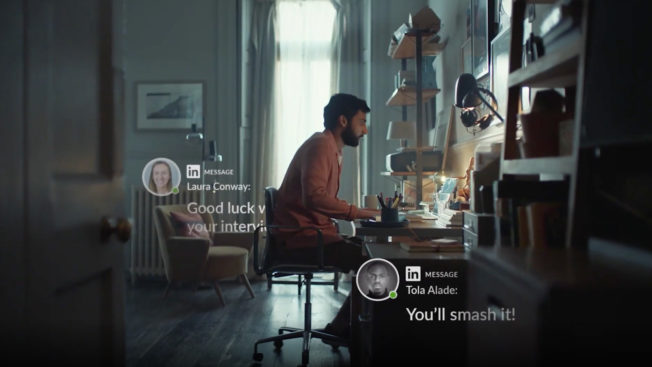6 HOURS AGO
Video is still very much “alive and well” on LinkedIn despite it shuttering its Stories function, states the platform’s recently promoted European and LATAM senior director Tom Pepper.

The decision to end Stories comes after a record year for the business, five years after Microsoft bought it for $26.2 billion. LinkedIn’s advertising business had annual revenue of $10 billion and grew 97% year-over-year, almost $3 billion compared to the previous 12 months over 2019 and 2020.
The value of video
Pepper admits that the introduction of video services came late to LinkedIn compared to other social media platforms. But this allowed it to consider people’s contributions “in a professional mindset” and what they wanted to gain from using video messaging.
“It works phenomenally well,” he says, “especially for b-to-b audiences, advertisers included.”

LINKEDIN TELLS THE STORY OF A MAN AND HIS PLANT AS THEY JOB HUNT
“That value is being created in the b-to-b world and the acceleration of b-to-b advertising is certainly being reflected on LinkedIn,” he explains, adding that advertising agencies are now working much more closely with it to understand the opportunities in reaching its worldwide audience. The most recent number was placed at over 774 million members across more than 200 countries and territories.
The platform announced that its Stories feature—which allowed users to add short-form video messages to their posts—would be suspended by the end of September, after only a year in use. The experience will now be “reimagined” across other parts of the site.
Video on LinkedIn remains “by far and away” the biggest way people engage with one another on the platform, according to Pepper.
Over half of its members engage with videos on their feed daily, according to the platform’s research, spending more than three times longer engaging with video posts over static messaging.
In March, LinkedIn introduced new tools and features for creators, like Cover Stories to introduce themselves, aimed at helping them publish more content.
“Members see the value in it. You can see people creating their own videos or using video as a way of communicating,” he said, adding that animation tools especially have been working well based on feedback.
“[Video] is one of the most engaging formats we have and we’re going to continue to invest in it because that’s what the members want,” he said.
LinkedIn has also been working on using its video service to host events and has begun testing paid online events, prompted by the physical restrictions introduced over the last 18 months by the Covid-19 pandemic. One partner is business publication the Financial Times, which hosted events like its Future of Retail series as recently as the end of September.
“We’ve measured event attendees’ engagement with articles hosted on the FT’s website for the six months prior to an event and then for six months afterward to see the impact a single event might have,” Tania Marshall, global marketing director of the Financial Times, said in a statement.
“In the six months after their attendance, engagement on FT.com skyrocketed. In the past, events have been seen as a revenue driver. Now we see them as an engagement driver. They have a big impact on our customers’ lifetime value.”
High performing and higher cost
Agencies agree with the platform’s credentials in reaching C-suite and decision makers in a professional context, but now marketers are beginning to see incremental value in reaching consumers there too, thanks to its targeting capabilities.
“The development of LinkedIn’s video capabilities has only helped drive incremental growth, enabling advertisers to promote attention-grabbing content in a brand-safe and contextually relevant environment,” Alice Hennessy, global investment partner, partnerships for Wavemaker told Adweek. “While we are seeing higher engagement on video formats (through comments, reactions, shares and follows), the cost tends to be higher when compared to other social platforms.”
And compared with other video-heavy feeds on social platforms, LinkedIn is less saturated, making targeting cohorts more effective.
“Where LinkedIn lets us down is being able to test video alongside image creative,” Danielle Carter, senior social advertising manager at digital marketing agency Croud, told Adweek.
“The need to create separate campaigns means that audiences can be diluted,” she added. “To get around this, you need to have a more segmented testing approach. Despite now being removed, Story placements were introduced as video ads. However, there was the inability to adapt video creative for that placement, so content could look odd or story-first creatives were used in feeds and cropped.”
Despite those shortcomings, Carter notes that video activity on LinkedIn should be included in content strategies because of how specific and granular marketers can make it.
* This article was originally published here

